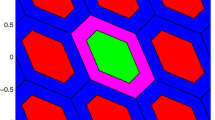Abstract
To ensure reliable ambiguity resolution, ambiguity validation is an indispensable step. It has been a challenge for many years and is far from being resolved. Over the past years, various ambiguity validation methods have been proposed, such as F-ratio test, R-ratio test, difference test, projector test, ellipsoidal integer aperture (EIA) estimator and penalized integer aperture (PIA) estimator. In this paper, through analysis and testing, we find that, when the aperture region of EIA is not allowed to be overlapped, the efficiency of ambiguity resolution with EIA is low and it is not applicable to fast static positioning or real-time kinematic (RTK) applications. Then EIA with overlapped aperture regions is recommended and the resulted fail-rate becomes upper bound of the actual one. After that, it is suggested that combined use of overlapped EIA and R-ratio test can increase the reliability of ambiguity resolution. Finally, numerical tests are carried out based on practical buoy data and simulated Galileo data.
Similar content being viewed by others
References
Abidin H (1993) Computational and geometrical aspects of on-the-fly ambiguity resolution, Ph.D.Thesis, Dept. of Surveying Engineering, Tech. Report No. 104, University of New Brunswick, Canada
Euler H, Landau H (1992) Fast GPS ambiguity resolution on-the-fly for real-time application. In: Proceedings of six international geodetic symposium on satellite positioning, Columbus, Ohio, 17–20 March, pp 650–659
Euler H, Schaffrin B (1991) On a measure for the discernibility between different ambiguity solutions in the static-kinematic GPS-mode. In: IAG Symposia No. 107, kinematic systems in geodesy, surveying, and remote sensing. Springer, New York, pp 285–295
Frei E, Beutler G (1990) Rapid static positioning based on the fast ambiguity resolution approach FARA: theory and first results. Manuscripta Geodaetica 15(4): 325–356
GAL OS SIS ICD/D.0 (2006) Galileo open service signal in space interface control document, ref GAL OS SIS ICD/D.0, Issue: Draft, Revision: 0, Date: 23/05/2006
Han S (1997) Quality control issues relating to instantaneous ambiguity resolution for real-time GPS kinematic positioning. J Geodesy 71: 351–361
Hofmann-Wellenhof B, Lichtenegger H, Collins J (1997) Global positioning system: theory and practice. Springer, Berlin
Hopfield H (1969) Two-quadratic tropospheric refractivity profile for correction satellite data. J Geophys Res 74(18): 4487–4499
Klobuchar J (1987) Ionospheric time-delay algorithm for single-frequency GPS users. IEEE Trans Aerosp Electron Syst 23(3): 325–331
Leick A (2004) GPS satellite surveying, 3rd edn. Wiley, New York
Parkinson B, Spilker JJ (1996) GPS: theory and applications, vols 1, 2. AIAA, Washington
Teunissen P (1995) The least-squares ambiguity decorrelation adjustment: a method for fast GPS integer ambiguity estimation. J Geodesy 70(1-2): 65–82
Teunissen P (1998) On the integer normal distributions of the GPS ambiguities. Artif Satell 33: 49–64
Teunissen P (1998) Success probability of integer GPS ambiguity rounding and bootstrapping. J Geodesy 72: 606–612
Teunissen P (1999) An optimality property of the integer least-squares estimator. J Geodesy 73: 587–593
Teunissen P (2000) ADOP based upperbounds for the bootstrapped and the least-squares ambiguity success rates. Artif Satell 35(4): 171–179
Teunissen P (2002) The parameter distributions of the integer GPS model. J Geodesy 76: 41–48
Teunissen P (2003a) Integer aperture GNSS ambiguity resolution. Artif Satell 38(3): 79–88
Teunissen P (2003b) An invariant upper bound for the GNSS bootstrapped ambiguity success rate. J Global Position Syst 2(1): 13–17
Teunissen P (2004) Penalized GNSS ambiguity resolution. J Geodesy. doi:10.1007/s00190-004-0393-2
Teunissen P, Verhagen S (2004) On the foundation of the popular ratio test for GNSS ambiguity resolution. In: Proceedings of ION GNSS-2004, Fairfax, VA, pp 79-88
Teunissen P (2005) A carrier phase ambiguity estimator with easy-to-evaluate fail-rate. Artif Satell 38(3): 89–96
Teunissen P, Verhagen S (2009) The GNSS ambiguity ratio-test revisited: a better way of using it. Surv Rev 41(312): 138–151
Tiberius C, Jonge P (1995) Fast positioning using the LAMBDA method. In: Proceedings of DSNS-95, Bergen, Norway, Paper No. 30
Verhagen S (2005) The GNSS integer ambiguities: estimation and validation. Ph.d. thesis, Publications on Geodesy, 58, Netherlands Geodetic Commmission, Delft
Wang J, Stewart M, Tsakiri M (1998) A discrimination test procedure for ambiguity resolution on-the-fly. J Geodesy 72: 644–653
Xu P (2006) Voronoi cells, probabilistic bounds, and hypothesis testing in mixed integer linear models. IEEE Trans Inf Theory 52: 3122–3138
Author information
Authors and Affiliations
Corresponding author
Rights and permissions
About this article
Cite this article
Ji, S., Chen, W., Ding, X. et al. Ambiguity validation with combined ratio test and ellipsoidal integer aperture estimator. J Geod 84, 597–604 (2010). https://doi.org/10.1007/s00190-010-0400-8
Received:
Accepted:
Published:
Issue Date:
DOI: https://doi.org/10.1007/s00190-010-0400-8




